Khrutsky flowers and fruits. To save his family from poverty, the Belarusian artist Ivan Khrutsky refused world fame
Ivan Khrutsky is the most famous and at the same time the most unknown Belarusian artist. Everyone knows his paintings. Still - Belarusians hold a fragment of one of the still lifes in their hands many times every day. After all, it is he who is located on the thousandth bill. At the same time, rarely anyone can remember his name. "Beloved stranger" - this is what art critics call him, for whom there are still many mysteries and white spots in Khrutsky's biography and work.
Before the war, there was not a single painting by Khrutsky in Belarus
Actually, this artist was discovered for Belarusians only in the post-war years. The legendary Elena Aladova, who revived the current Art Museum and collected a collection for it, set out to return Khrutsky's paintings to their homeland. After all, he was one of the few artists with a "pure" Belarusian biography: he was born in Belarus, lived in Belarus, died and was buried in Belarus. Over 30 post-war years Elena Vasilievna managed to buy 25 paintings by Khrutsky from private collectors.
It turned out that buying paintings is easier than finding out the details of their creation. The nineteenth century, in which the artist lived (born in 1810, died in 1885), was an epistolary era, a time when memoirs and memoirs were written. In the 30s, daguerreotypes appeared, and everyone rushed to be photographed. After Khrutsky, not a single letter, photograph, or memoir remained.
But Khrutsky was lucky in another way. From other artists, only memories remained, but no paintings remained. And after Khrutsky, more than 100 canvases have been preserved, - Nadezhda Usova, deputy director of the National Art Museum, is sure. - So - they loved, kept, cherished.
|
From PR to artists
The eldest son of a Uniate priest, in principle, had to continue the work of his father. It is for this that at the age of 10 he was sent from his native Usaya to Polotsk to the PR Lyceum - monastic order engaged in youth education. Education there was brilliant, because the lyceum students studied mathematics, physics, metaphysics, Latin, rhetoric, versification. True, the Russian language for Polish-speaking students was as a foreign language, on a par with French and German.
But at the age of 17, Ivan decides to go to St. Petersburg to study as an artist. Why St. Petersburg, because in Vilna there was already a university with a department of arts? But a young man who does not speak Russian well goes to the capital, which, as you know, does not wait for anyone. Whether someone supported him, whether he had a patron or philanthropist, nothing is known about this. But, apparently, he had a hard time.
Polish researchers managed to question the artist's grandson shortly before his death. But the 84-year-old old man told them family legends rather than facts. For example, that Khrutsky in St. Petersburg began to take lessons from George Dow, a brilliant English painter who was invited to the Winter Palace to paint 327 portraits of the heroes of the war of 1812. Why should he give lessons to a boy from Polotsk? Most likely, Khrutsky simply brought colors to the Englishman. And he enters the Academy of Arts as an "outsider" student.
But the young man seemed to have strong character and boundless ambition. After all, in order to survive, it was necessary to earn money, and in order to earn money, it was necessary to have connections and recognition. However, over the past almost 200 years, nothing has changed.
Ivan Khrutsky found connections among fellow countrymen who settled in St. Petersburg. Academician of the Academy of Arts, gentry of the Minsk province, Freemason and good-natured Ezef Oleshkevich got him a visit to the Hermitage, which was not yet a museum. To get in royal palace possible only by recommendation.
Founder of Russian still life
It is there that he makes copies of Dutch still lifes, and adapts them to academic taste and romantic tendencies, says Nadezhda Usova.
Soon, the still lifes painted by the artist Ivan Khrutsky adorn the salons and living rooms of the capital's public. And despite the fact that the genre of still life was already in decline, Khrutsky returns fashion to them and becomes her trendsetter. He has to do 6-7 repetitions of each still life, so they become popular. So the first money and the first recognition come to him. For the still life "Flowers and Fruits" he receives the first award - a small silver medal of the Academy of Arts. And this is at 26 years old. Two years later he already has a small gold medal. It remains to get a big gold medal to make the dream of any Russian artist of that time come true. The owner of gold medals could qualify for six years in Italy at public expense. The Academy of Arts compiled a program for artists, and they had to send the works written according to it to their homeland. That is how Alexander Ivanov came to Italy, who spent 20 years writing "The Appearance of Christ to the People" there.
But these grandiose plans were not destined to come true.
Saved my father from the shackles of the monastery
Khrutsky's father Foman Khrutsky opposed the unification of the Uniate Church with the Orthodox. By the way, one of the initiators of such an association was Bishop Joseph Semashko, who later played a significant role in the fate of the artist. A revision immediately descended on the parish of priest Khrutsky, they impose a penance on him and send him to the monastery for bread and water, since priests were not imprisoned.
Ivan Khrutsky immediately writes a letter to Metropolitan Josaphat Bulgak, his father is released. And Ivan, obviously, in gratitude for this release, paints portraits of the entire leadership of the Uniate Church.
But as soon as the Uniate Church was banned in 1839 and the priest Foma Khrutsky found himself without a parish, he dies. There remains Ivan's mother and five younger brothers and sisters. He must take care of the family. Farewell Italy!
At the age of 29, Ivan achieves the title of academician of the Academy of Arts "for excellent work in portraiture, landscape painting, and especially in painting fruits and vegetables." This title was given by the nobility, and not only personal, but also hereditary. Khrutsky became, in fact, twice a nobleman, because at about the same time he was able to confirm title of nobility his family. Confirmation nobility at the gentry Russian empire demanded after the uprising of 1830.
But what about family? younger brothers he took to St. Petersburg, where his sisters and mother were, is unknown. Perhaps they lived with relatives. Khrutsky works very hard. For three years, he painted 21 portraits, that is, every 2-3 months. Today, these people are called workaholics. And he writes the mighty of the world like the mayor of St. Petersburg or the publisher of Pushkin and Lermontov Ilya Glazunov. He really needs money.
|
Instead of Italy - Zakharnichi
And in 1844, at the age of 34, he buys land near Polotsk. In those days, only an Orthodox, Russian-speaking nobleman had the right to such a purchase. Khrutsky builds a house on the shore of the lake according to his own design, lays out a garden, which was then considered a luxury. The artist also establishes connections here - he paints portraits of the leaders of the nobility of the Vitebsk province, Polotsk province, Lepel district ...
A year later, he marries a neighbor, Anna-Katarina Bembnovskaya, and ... soon leaves. The same Bishop Semashko invites him to Vilna to decorate the bishop's house, to paint the porters of the clergy.
Some of the researchers believed that Khrutsky fell into bondage, says Nadezhda Usova. - Actually it was a great success. He found a philanthropist who regularly gave him orders, provided him with housing and money.
Probably, these ten years that the artist lived in two houses explain why he had only two children. Years later, Semashko "let go" of Khrutsky before his death. He returns to Zakharnichi and turns into a real landowner. He is actively engaged in farming, although he continues to paint portraits of children and his favorite fruits, mushrooms and vegetables. But we know very little of the work of that period.
I have my own version of why this happened. Firstly, in the 30s, the daguerreotype appeared, and everyone rushed to be photographed. There was no longer such a demand for portraits. And secondly, passed bloody uprising 1863, which affected many landowners - someone was exiled, someone was shot, someone emigrated. But the apolitical and loyal Khrutsky did not participate in it in any way. I think he just stopped giving orders.
Ivan Khrutsky spent the last twenty years of his life in complete oblivion. He probably did not even know that Tretyakov himself bought his still life at one of the auctions in Moscow for his gallery. And to get to Tretyakov meant recognition of the undoubted artistic merit of the picture.
Before his death, Khrutsky wrote two self-portraits - for his son and daughter. This is the only image of the artist that has come down to us. After his death in 1885, an obituary for the death of an academician of the Academy of Arts did not appear either in Polotsk, or in Vitebsk, or in St. Petersburg. Complete oblivion.
The artist's heirs lived in Zakharnichi back in the 1920s. After the estate was nationalized, the house burned down, the cemetery was demolished, the grave of Ivan Khrutsky disappeared. The monument stands in the place indicated by the memoirs of the great-granddaughter.
The riddles of the artist
Unknown woman with flowers - wife or sister?
Khrutsky has many charming female portraits. But it still remains a mystery - who are these women. Many art historians are perplexed why the artist did not capture his wife on any canvas, although he painted all the relatives.
But long before his marriage, he painted all the time the same woman, whom we know well from the painting "Unknown Woman with Flowers and Fruits." She is on his canvases as a little girl, an adult, pregnant, aged. There is a legend in the family of Khrutsky's descendants that this is still his wife, whom he knew as an 8-year-old girl, and when he built the estate, he married her. But I'm guessing "Unknown" is his little sister. And all the female girls on his canvases in the images of "beautiful gardeners" are his sisters. After all, they look alike.
|
|
|
site is an information-entertainment-educational site for all ages and categories of Internet users. Here, both children and adults will have a good time, they will be able to improve their level of education, read interesting biographies of great and famous people in different eras, watch photographs and videos from the private sphere and public life popular and eminent personalities. Biographies talented actors, politicians, scientists, pioneers. We will present you with creativity, artists and poets, music of brilliant composers and songs of famous performers. Screenwriters, directors, astronauts, nuclear physicists, biologists, athletes - many worthy people that left an imprint in time, history and development of mankind are brought together on our pages.
On the site you will learn little-known information from the fate of celebrities; fresh news from cultural and scientific activity, family and personal life stars; reliable facts of the biography of prominent inhabitants of the planet. All information is conveniently organized. The material is presented in a simple and clear, easy to read and interestingly designed form. We have tried to ensure that our visitors receive here necessary information with pleasure and great interest.
When you want to find out details from the biography of famous people, you often start looking for information from many reference books and articles scattered all over the Internet. Now, for your convenience, all the facts and the most complete information from the life of interesting and public people collected in one place.
the site will tell in detail about the biography famous people left their mark on human history, both in ancient times and in our modern world. Here you can learn more about the life, work, habits, environment and family of your favorite idol. About the success stories of bright and extraordinary people. About great scientists and politicians. Pupils and students will draw on our resource the necessary and topical material from the biography of great people for various reports, abstracts and term papers.
Learn biographies interesting people who have earned the recognition of mankind, the occupation is often very exciting, since the stories of their destinies capture no less than other works of art. For some, such reading can serve as a strong impetus for their own accomplishments, give confidence in themselves, and help them cope with a difficult situation. There are even statements that when studying the success stories of other people, in addition to motivation for action, there are also leadership skills, strength of mind and perseverance in achieving goals are strengthened.
It is also interesting to read the biographies of rich people posted with us, whose perseverance on the path to success is worthy of imitation and respect. big names past centuries and the present day will always arouse the curiosity of historians and ordinary people. And we set ourselves the goal of satisfying this interest to the fullest extent. Do you want to show off your erudition, prepare thematic material, or are you just interested in learning everything about historical figure- go to the site.
Fans of reading people's biographies can adopt them life experience, learn from someone else's mistakes, compare yourself with poets, artists, scientists, draw important conclusions for yourself, improve yourself using the experience of an extraordinary personality.
Studying biographies successful people, the reader will learn how great discoveries and achievements were made that gave humanity a chance to ascend to a new stage in its development. What obstacles and difficulties had to overcome many famous people arts or scientists, famous doctors and researchers, businessmen and rulers.
And how exciting it is to plunge into the life story of a traveler or discoverer, imagine yourself as a commander or a poor artist, learn the love story of a great ruler and get to know the family of an old idol.
The biographies of interesting people on our site are conveniently structured so that visitors can easily find information about any person in the database. the right person. Our team strived to ensure that you like both simple, intuitive navigation, and easy, interesting style of writing articles, and original page design.
In the history of Belarusian and Russian painting I.F. Khrutsky entered, first of all, as a master of still life, although for his long creative life the artist created many portraits, landscapes, interiors, painted icons.
Ivan Khrutsky was closely associated with Belarus: he was born in 1810 in the town of Ulla, Lepel district, Vitebsk province, in the family of the Uniate priest Foma Khrutsky, studied at the Polotsk Higher PR School, which he graduated around 1827 and where, most likely, he received his first professional skills. Perhaps, already in childhood, I. Khrutsky showed interest in painting, or perhaps this was determined during the years of study at the school.
Belarus did not have educational institutions, where it was possible to get a higher artistic professional education, and talented young people were forced to leave to study in St. Petersburg, Moscow or Europe.
When Ivan Khrutsky arrived in St. Petersburg in 1827, he already had a good command of drawing and entered the Imperial Academy of Arts as a freelance student, and also began taking painting lessons from George Dow (1781-1829), an English painter who worked in 1818-1828 years in Russia.
The circle of his acquaintances in St. Petersburg is almost unknown to us, but it has been established that he received a ticket for the right to copy in the Imperial Hermitage in 1830 "on the recommendation of Mr. Academician Oleshkevich." The practice of copying as a form of education was widespread in Russia, including at the Academy of Arts. I.F. Khrutsky successfully copied the works of European masters of the 17th-18th centuries, comprehending the experience of European classical art, assimilating the skills, techniques of writing, and the laws of composition.
It can also be assumed that through his fellow students at the Academy of Arts (for example, A. Tyranov), the young artist gets acquainted with the teaching methods of the famous Russian artist and teacher A.G. Venetsianov (1780-1847). With the Venetian style of painting, Khrutsky is brought closer by the same reverently attentive attitude to the surrounding objective world, depicted by the artist in all the smallest details.
A lot in the work of I.F. Khrutsky due to his studies at the Academy of Arts. A smooth, glazing manner of writing, a dominant local color, a static frontal composition in still lifes, in the center of which, as a rule, is a lush bouquet of bright, illusoryly painted garden flowers. The compositional and coloristic solution, the picturesque illusionistic manner of reproducing objects in his still lifes comes, first of all, from the academic “studies of flowers and fruits”. In 1836, Ivan Khrutsky graduated from the Academy of Arts, having received the title of a non-class (free) artist and a large silver medal for the painting “Flowers and Fruits” (now in the State Tretyakov Gallery, a variant in the National Art Museum of the Republic of Belarus). In 1837, the artist was marked by Emperor Nicholas I with a watch on a gold chain "as an encouragement to further work." In 1838, for the paintings "Flowers and Fruits" and "The Old Woman Knitting a Stocking" (both in the State Tretyakov Gallery) I.F. Khrutsky was awarded a small gold medal of the Academy of Arts.
The works of Ivan Khrutsky in the 1830-1840s were exhibited at the exhibitions of the Academy of Arts, played in the lottery of the St. Petersburg Society for the Encouragement of Artists, were very popular with the viewer, attracting with bright color, festivity, representativeness. The artist received many orders, hence the abundance of options and repetitions of his still lifes. I. Khrutsky found his theme in art and in the first half of the 19th century was the best and most in demand in this subject. He is the most famous and most "purchasable" master of still life of the XIX century in the Russian Empire.
The canvas by I. Khrutsky of 1839 “Still Life with Binoculars” was so popular with his contemporaries that the artist repeated it several times. To date, eight repetitions are known under different names: “Fruits and a candle” (NXM RB), “Still life with binoculars”, “Still life with a candle”. The traditional jug in the center of the canvas is accompanied by a wicker basket with grapes, familiar to us from other canvases, and a bast box with apples. A smoking cigar and binoculars in the foreground, a lit candle seem to indicate the presence of a person in the space around the picture.
In developing new principles of still life painting, I. Khrutsky, of course, was guided by certain examples of European painting of the 17th - 18th centuries, for example, the traditional motif Dutch still lifes- a half-peeled lemon with the zest cut off, spiraling down from the countertop, a glass half-filled with water. The artist's gift to organically combine the impressions of classical still lifes with new semantic accents was most clearly manifested in the still lifes of the 1830s - "Fruits and Melon", "Flowers and Fruits" (1839), "Roses and Fruits". (1839).
Ivan Khrutsky, who was formed as an artist in the traditions of Russian art of the first half of XIX century, at the same time he created a new interpretation of still life for art, transforming the skills of European still life in it.
In 1839 I. Khrutsky received the title of academician Imperial Academy of Arts "for excellent work in portraiture, landscape, and especially in painting fruits and vegetables" and with each new work he confirmed the attitude already established among art lovers towards him as a highly professional master.
Then he creates a number of female portraits, distinguished by a subtle combination of warmth and dignity in the interpretation of images. In these portraits, the artist organically combined his idea of \u200b\u200bfemale beauty with the romantic idea of the ideal characteristic of the time. A significant role in these portraits was given to still life (“Portrait of an Unknown Woman”, mid-1830s).
“Portrait of an Unknown Woman with Flowers and Fruits” of 1838 is an almost ceremonial canvas in terms of composition, mood and coloristic accents, in which I.F. Khrutsky achieves pictorial completeness and completeness. It was this picture that business card not only the collections of the artist in the National Art Museum of the Republic of Belarus, but also the museum as a whole.
A certain influence on the work of I. Khrutsky was exerted by the art of the European Biedermeier. In the culture of the Biedermeier era, a new type of artist was in demand, maintaining ties with academic art and responding with his work to the needs of the general public.
Biedermeier painting has an inherent interest in the child's world. The artist Ivan Khrutsky also paid tribute to this theme. In the “Portrait of a Girl in a Blue Dress” of the mid-1840s, the artist follows the canons of a representative salon portrait. The girl is depicted in full growth, in a smart dress, against the backdrop of the park. Nearby is a dog, a constant companion, whose presence brings revival to the composition. The portrait of the "Boy in a Straw Hat" (late 1830s - early 1840s) is distinguished by greater compositional and coloristic restraint.
One of the defining motifs in the work of the Biedermeier masters were family scenes and portraits in the interior. In Khrutsky's canvas “In the rooms of the artist's estate. Children in front of an easel ”(1854-1855) in a careful depiction of the details of the situation, the details of everyday life, life, the naturalness of the depicted space, the organic presence of children in it, one can feel sincere love for the family, the home.
In the same years - from the end of the 1830s - the artist was also in demand as a portrait painter. Many famous people of Belarus, Russia, Lithuania order their portraits from him. In 1838, the “Portrait of Josaphat Bulgak”, the Uniate metropolitan, who lived at that time in St. Petersburg, was painted, in 1843 - one of the best in the heritage of I. Khrutsky “Portrait of I.I. Glazunov, the largest Petersburg book publisher.
In 1839 the artist's father died. Ivan Khrutsky, as the eldest son, was responsible for the fate of his mother, brothers and sisters. He is forced to leave St. Petersburg, where he was already widely known and in demand, and go to his homeland, to Belarus. In 1844 I.F. Khrutsky acquired the Zakharnichi estate near Polotsk, built a house, choosing the enfilade arrangement of rooms, adopted in the architecture of the first half of the 19th century, in 1845 he married Anna Ksaveryevna Bembnovskaya (1822 - 18 ...). From that time until the end of his life, he lived and worked in his homeland, with the exception of the decade from 1846 to 1854-55, when he worked in Vilna on the orders of Archbishop (from 1852 - Metropolitan) Joseph Semashko. It is known that in Vilna Khrutsky painted icons for the iconostases of the Alexander Nevsky Cathedral in Kovno (Kaunas), the cave church of the Three Martyrs in Vilna, the Church of St. Joseph the Betrothed in Trinopol. In addition, he performed for I. Semashko copies of works by European artists, landscapes of Vilna and its environs. By order of the Archbishop, I. Khrutsky painted 32 portraits (all of the same size) of persons of the clergy, including the only one that has survived to this day, “Portrait of Vikenty Lisovsky” (1847), hieromonk, confessor I. Semashko, a portrait of the archbishop himself, and in 1854 In the same year, his portrait in the interior - “Metropolitan Joseph Semashko listens to the secretary’s report in his office” (now in the State Russian Museum).
During these years, living in Vilna and Zakharnichi, he painted portraits, landscapes, still lifes, and interiors. In the still life of 1954 "Bad Game, Vegetables and Mushrooms", while maintaining the traditional compositional solution, the artist strives for greater object-domestic concreteness, less pomposity; it can be assumed that the still life was painted from nature.
about documentary evidence and works of art, except for the "Self-Portrait" of 1884, stored in the State Russian Museum (St. Petersburg), and the still life "Flowers and Fruits" (1869) from the Vyatka Art Museum, created in the last years of the life of Ivan Khrutsky, we do not know.
In 1985 at the National Art Museum of the Republic of Belarus ( then GHM BSSR) was organized the first and so far the only personal exhibition of works by I.F. Khrutsky from the largest museums in Belarus, Russia, Lithuania, Poland, Latvia, from private collections. An album-catalog was published, which has now become a bibliographic rarity, in which, in addition to an article with new biographical information and an analysis of creativity, almost all well-known works of the artist at that time.
In 2009, the National Art Museum of the Republic of Belarus opened an expanded exposition of works by Ivan Khrutsky, the most important master of still life in the painting of Belarus and Russia of the 19th century. “It was Ivan Khrutsky who defended the honor of still life as a genre of great art, it was he who kept alive in Russian artistic environment high still life ideals classical eras” 4.
T.V. Alekseev. Artists of the Venetsianov School. - M., 1982. - S. 132.
Iosif Ivanovich Oleshkevich (1777-1830) - Belarusian, Lithuanian and Russian painter, portraitist, academician of the Imperial Academy of Arts. He was a member of the inner circle of A.S. Pushkin, A. Mitskevich.
3 Index to the "Collection of materials for the history of the Imperial St. Petersburg Academy of Arts over a hundred years of existence" / Compiled by A.E. Yundol. St. Petersburg, 1887. - S. 333.
Ivan Khrutsky. 1810 - 1885. Album - catalog / Autars - warehouses I.M. Panshyn, A.K. Resina. Minsk, 1990.
4 Bolotina I.S. Still life in Russian painting of the XVIII-XIX centuries. Abstract of diss. ... candidate of art history. - M.: Moscow State University. M.V. Lomonosov, 1971.
Fruit and melon. Second floor. 1830s.
Option-repetition of the painting "Flowers and Fruits" in 1836, located in the State Tretyakov Gallery, for which the artist received a silver medal.
Canvas, oil. 49 x 67. To the right, along the edge of the table: I. Khrutsky
Fast. In 1955 from the funds of the DHVP. Earlier collection of V.M. Mazov. ZhB-5 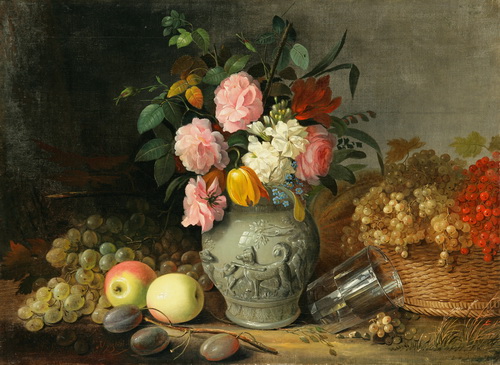
Still life. Flowers and fruits. 1839.
A repeating version of the painting called "Flowers and Fruits" is in the timing.
Canvas, oil. 49x66.4. Bottom left: 1839 Khrutsky
Acquired in 1964 at M.D. Tsireshkin. M. ZhB-9 
Fruits and a candle. Late 1830 - early. 1840s.
Option-repetition of the paintings of 1839 "Still life with binoculars" (National Museum. Warsaw) and "Still life with a candle" (collection of L. Tsurkis. L.) The picture was repeatedly repeated.
Canvas, oil. 66.5 x 87.7. Bottom right: I. Khrutsky
Acquired in 1957 O.K. Treskina. M. ZhB-11 
Flowers and fruits. 1840.
A repetition option called "Fruit" is in the timing.
Canvas, oil. 71.5 x 89. Left on the tabletop: I. Khrutsky 1840
Acquired in 1968 at F.E. Vishnevsky. M. ZhB-13 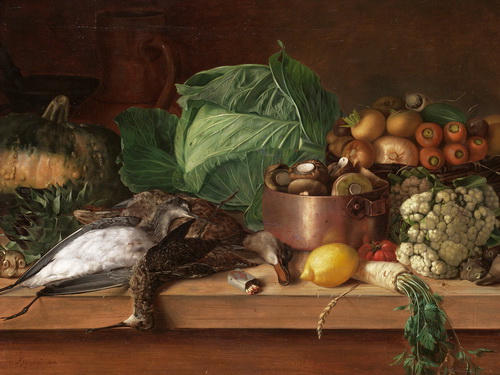
Dead game, vegetables and mushrooms. 1854.
Canvas, oil. 54.2 x 71.7. Bottom left: I. Khrutsky 1854 .
On the stretcher there is an inscription: coll. Khrutskaya-Makeevskaya.
Acquired in 1963 at B.N. Gribanov. M. Previously, the collection of E.I. Matseevskaya. L. ZhB-21 
Portrait of an unknown with flowers and fruits. 1838.
Canvas, oil. 80.2 x 112. Bottom right: Khrutsky 1838
On the back: inscription: From the collection Stan. Ant. Bilvin; text sticker:
Own Stroganova Cl. M.
Acquired in 1960 at K.M. Chulanova. L. Earlier collection of S.A. Bilvin. P. ZhB-6 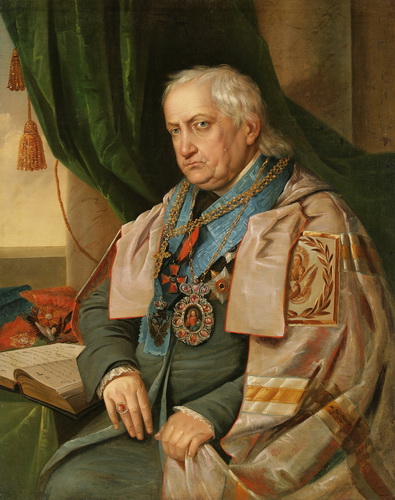
Portrait of I. Bulgak. 1838.
Canvas, oil. 100.7 x 80. Bottom right: M: Jan Chrucki 1838 Acr. in 1957 at A.M. Shuster. L. ZhB-7 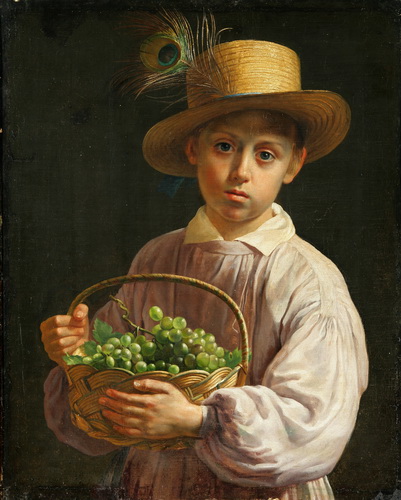
Portrait of a boy in a strawhat. Late 1830 - early. 1840s.
Canvas, oil. 66 x 53. Bottom left: I. Khrutsky Acquired. in 1957 at Yu.V. Nevzorov. M. ZhB-12 
Portrait of I. I. Glazunov. 1843.
Canvas, oil. 83.8 x 67. Bottom left: I. Khrutsky 1843
On the back there is an inscription: Glazunov Ilya Ivanovich born. July 13, 1876 + Feb. 20 1849. Reproduced in the Dictionary ± Rovinsky Volume II p. 567.
Acquired In 1954, A.V. Gordon. M. ZhB-16
Depicted is Ilya Ivanovich Glazunov (1786 - 1849), one of the representatives of the largest trading and publishing firm of the Glazunovs in Moscow and St. Petersburg, which existed from 1782 to 1917.

Portrait of V. Lisovsky. 1847.
Canvas, oil. 45 x 35. Bottom left sleeve: pinxit Joan Chrucki 1847
There is an inscription on the back of the duplicating canvas: On the original canvas it is written: Vikentij Lisovsky painted Ivan Khrutsky. 1847 .
Acquired in 1987 at A.P. Ivanchenko. L. Previously, the collection of L.M. Rosenfeld. L. ZhB-19
Depicted is Vikenty Lisovsky, hieromonk, confessor of Archbishop Joseph Semashko. He lived in the Trinity Monastery in Vilna.
January 27, 1810 - January 13, 1885
Belarusian and Russian artist, painter
Biography
Ivan Khrutsky was born on January 27, 1810 in the family of the Greek Catholic priest Foma Ivanovich Khrutsky. Belarusian..
Ivan Khrutsky received his secondary art education at the Polotsk Higher PR School. In 1827 he comes to St. Petersburg. Here, until 1829, he took lessons from the English painter J. Dow and at the same time studied at the Imperial Academy of Arts as a volunteer student. Copied in the Hermitage. In 1830 Khrutsky entered the Academy of Arts. There he studied with such masters as A. G. Varnek, M. N. Vorobyov, K. P. Bryullov, F. A. Bruni.
In 1839, after the death of his father, Ivan Fomich leaves St. Petersburg. In 1844, he acquired the Zakharnichi estate in the Polotsk district (20 km from Polotsk), where he built a house according to his own design and planted a garden. Since 1845, I. Khrutsky lived there permanently.
Creative activity
Ivan Fomich Khrutsky is known as an artist who worked in line with the Russian academic school. He entered the history of art with his still lifes.
The first dated studies of the artist - "Still Life with a Vase" and "Still Life with a Bird" - date back to 1832. The main direction of Khrutsky's work during this period was work on a still life, referred to in official documents as "painting flowers and fruits". At this time, he creates a group of works similar in style - "Fruits and a bird" (1833); "Fruits" (1834); "Grapes and Fruits", "Still Life with Apples, Grapes and Lemon", which were distinguished by their simplicity of composition.
Soon, I. F. Khrutsky moved from early productions, consisting of only a few objects, to significant-sized still life paintings with a complex composition that combines many different vegetables, fruits and flowers: “Flowers and Fruits” (1836, 1839); "Still life with a candle", "Flowers and fruits", "Fruits, fruits, dead game" (all 1830s).
In 1836, for the painting "Flowers and Fruits" I. Khrutsky was awarded Academic Council large silver medal. In the same year, he was awarded the title of free artist "in consideration of good knowledge in landscape painting." Ivan Khrutsky was engaged in landscape painting throughout his subsequent work (“View on Elagin Island in St. Petersburg”, 1839; “View in the estate”, 1847).
Often the landscape served as a background in portraits and genre half-figures of the artist. So, in his most significant work of the 1830s - "Portrait of a Wife with Flowers and Fruits" (1838) - a young woman is depicted at a table filled with baskets of fruits, a decanter of water and a bouquet in a ceramic vase. The background for the whole scene is an autumn landscape, solved in crimson tones. A similar composition, which is a kind of synthesis of a genre portrait, still life and landscape, appeared in Khrutsky as a tribute to romanticism.
If the work of I. Khrutsky “Portrait of a Wife” is closer to the academic direction represented by such artists as K. P. Bryullov and F. A. Bruni, then another painting “An Old Woman Knitting a Stocking” (1838) brings him closer to artists, not who had academic education, for example, with A. G. Venetsianov and especially V. A. Tropipin. In 1838, for this work, as well as for the still life “Flowers and Fruits”, Ivan Khrutsky was awarded a small gold medal.
On September 24, 1839, I. F. Khrutsky "for excellent work in portraiture, landscape painting, and especially in painting fruits and vegetables" was awarded the title of academician of painting. Since that time, Khrutsky ceased to paint spectacular still lifes.
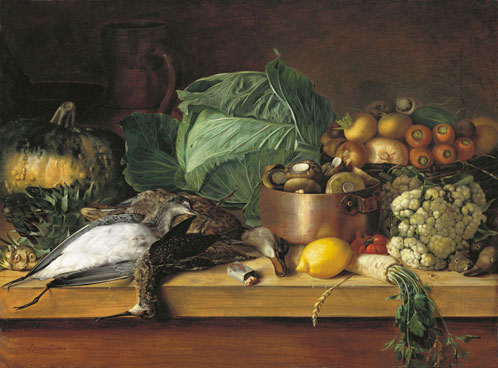


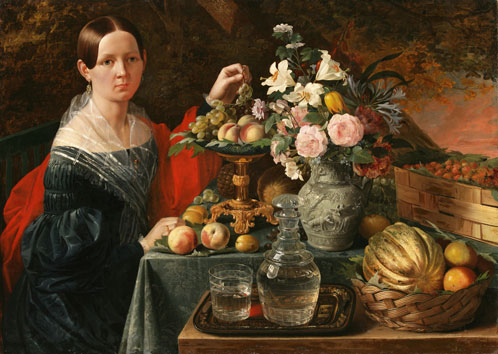

 Two heads and six legs; four walk, and two lie still
Two heads and six legs; four walk, and two lie still Self-esteem - what is it: concept, structure, types and levels
Self-esteem - what is it: concept, structure, types and levels Cassandra's Path, or Pasta Adventures War on Earth and Underground
Cassandra's Path, or Pasta Adventures War on Earth and Underground